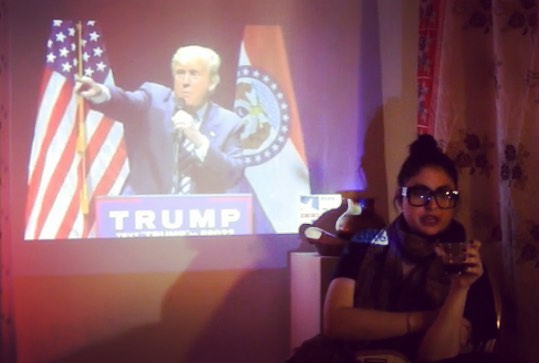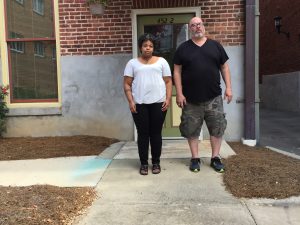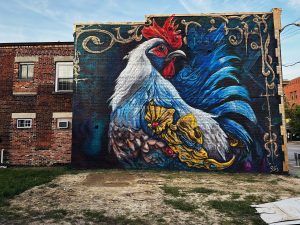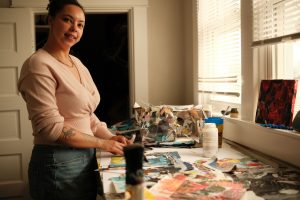“Power is fortified not just by what it destroys, but also by what it creates. Not just by what it takes, but also by what it gives. And powerlessness reaffirmed not just by the helplessness of those who have lost, but also by the gratitude of those who have (or think they have) gained.”
-Arundhatti Roy, The Greater Common Good
This essay comes to me from a place of rupture. It began over the summer, scanning through my newsfeed, learning that a friend from graduate school (Samantha Hill) had been “fired” two weeks into a three-month Social Practice residency in Georgia. I interviewed Samantha and the other resident, Ed Woodham, shortly after via email and phone, thousands of miles away in my new home in Los Angeles. Their experience brought up a lot of questions for me, in particular about how we, as artists, resist the seemingly unstoppable forces of capitalist white supremacist cis-hetero-patriarchy. The essay stalled. I kept finding more books and essays and articles to read. It felt like the answer was a PhD thesis, not an essay I write for the internet in my spare time. Then every fear I had been living with for over a year happened. The fear of the backlash to progressive change that congealed into the form of a vindictive, self-obsessed, misogynist, racist, xenophobic demagogue who whiteboyed his way into the most powerful position on the planet. What do my questions about the role of public art and arts institutions, our responsibility as artists and makers, the machinations of tertiary small-city nepotism matter in the face of He Who Must Not Be Named? Maybe it means nothing. Maybe it means everything. Maybe it is the pure potential in the sickening uncertainty of rupture.
From my interview with Samantha and Ed, you can get the broad strokes. Invited to be part of a residency in which they create a project that engages with a community through “Social Practice” they find troubling signs of the legacy of racial and class oppression in Macon bearing fruit within the program they are supposed to be a part of. Selected based on their prior experience working with communities, it becomes clear that who the community they are engaging with and why is to be determined by the institution, not the realities on the ground. In The Undercommons, Fred Moten and Stefano Harney say of the subversive intellectual in the university: “Her labor is as necessary as it is unwelcome. The university needs what she bears but cannot bear what she brings.” And they conclude that the only possible relationship with the university is a criminal one. If we extend their thinking from “University” to “Institution” we can see the roots of the problem and the horizons of our resistance.
Let’s back up for a second. When Samantha and Ed sent out their press release about being kicked out of the residency, Art F City covered it with a cursory article that concluded: “Despite each party having seemingly good intentions, as it stands now it’s impossible to understand the full story.” – We know it is possible though. Given resources, a reporter could have visited Macon, interviewed the people Samantha and Ed spoke with, and confirmed their story. The problem is there is no infrastructure within the art writing community to do this. We talk about the power art holds, and if we look at art history, we certainly see that it is inextricably tied to how we think about power, authority, and personhood. We say art is powerful, yet the vast majority of artists remain invisible, marginal. They are not paid a living wage for their labor, if they are paid at all. Serious art writers live in cities, mostly not paid well either, and focus their attention on the big players, primarily in New York. Is this starting to sound familiar? Something about bubbles? (My colleague Pedro Vélez has been writing and tweeting about this problem for years.)
I took a few hours to do some internet sleuthing, and it didn’t take me long to discover that the board of the Macon Arts Alliance (the MAA, which runs the Mill Hill Arts Village and Residency) included quite a few people involved in development and construction. Are we suspicious, then, of an “arts village” that inserts itself into an economically distressed black neighborhood, backed by an organization whose staff is entirely white, using the buzzwords of salivating developers (“urban blight” “renewal” etc.)? Are these not independent facts that bolster Samantha and Ed’s story?
Okay, we’re going to back up again. Like many parts of the South (and quite honestly, most of this country), Macon is a deeply racially segregated community. After Brown v. Board of Education, rather than send their children to public schools with black students, white families sent their children to private schools and defunded public schooling, creating generational systemic inequality. This dynamic was brought to national attention a few years ago when it was reported that many communities in Georgia still had segregated proms (since the “white” proms are private events funded by parents, black students could legally be kept out). This segregation bleeds out into the community as a whole, creating a “white” society and a “black” society, with very little overlap. As any person of color who has lived in or interacted with such intensely divided communities knows, often a certain amount of maneuvering is required to even become visible within the dominant white-supremacist society. So, it isn’t particularly hard to believe Samantha and Ed when they tell us that there are African American artists in and around Macon who feel that the MAA centers white artists and excludes black ones. It would almost be a super human feat for a private arts institution to resist the values of the culture it inhabits.
So, Samantha and Ed arrive in Macon, are not placed in the artist studios in Mill Hill (a small section of East Macon) as promised, but rather in an apartment downtown. They discover that the “neighborhood” they are supposed to engage with consists mostly of abandoned houses, with only a handful of households remaining. As they began interviewing members of the African American community (beyond the people and organizations directly associated with the Arts Village project), accusations of displacement emerged. At a community meeting organized to address questions in the wake of Samantha and Ed’s removal, a current resident of Mill Hill attested that her landlord had sold her home to the Urban Development Authority (UDA), without giving her an opportunity to purchase it, a scenario that the MAA and UDA had insisted was not occurring. In fact, many members of the African American community view the Arts Village as a displacement project meant to eventually gentrify East Macon as a whole (a largely African American community conveniently located adjacent to the rapidly developing—with the aid of the UDA—downtown district). It is certainly interesting that the board of the UDA includes the owner of a construction company, a realtor, and Gene Dunwody Jr. who is a partner in the Dunwody-Beeland firm. The Beeland in that firm is Robert Beeland, husband of Jan Beeland, who is Executive Director of the Macon Arts Alliance. Are your eyes squinting yet? What about the fact that Carey Pickard, who sits on the UDA board, is partners with Chris Howard, who sits on the board of the MAA? So, the Macon Arts Alliance (whose board consists of a surprising number of people connected with development for a non-profit whose primary goal is “promoting art”) gets a grant from the NEA and the Knight Foundation to partner with a development authority to create an arts village. Dunwody-Beeland kindly “donates” the labor of designing the new buildings, which are meant to house artists and “the community” – of course what community is left to house when they are bought out of their homes? How can people who were renting what amounted to sub-standard housing going to afford renovated homes many times the value of the house they were living in?
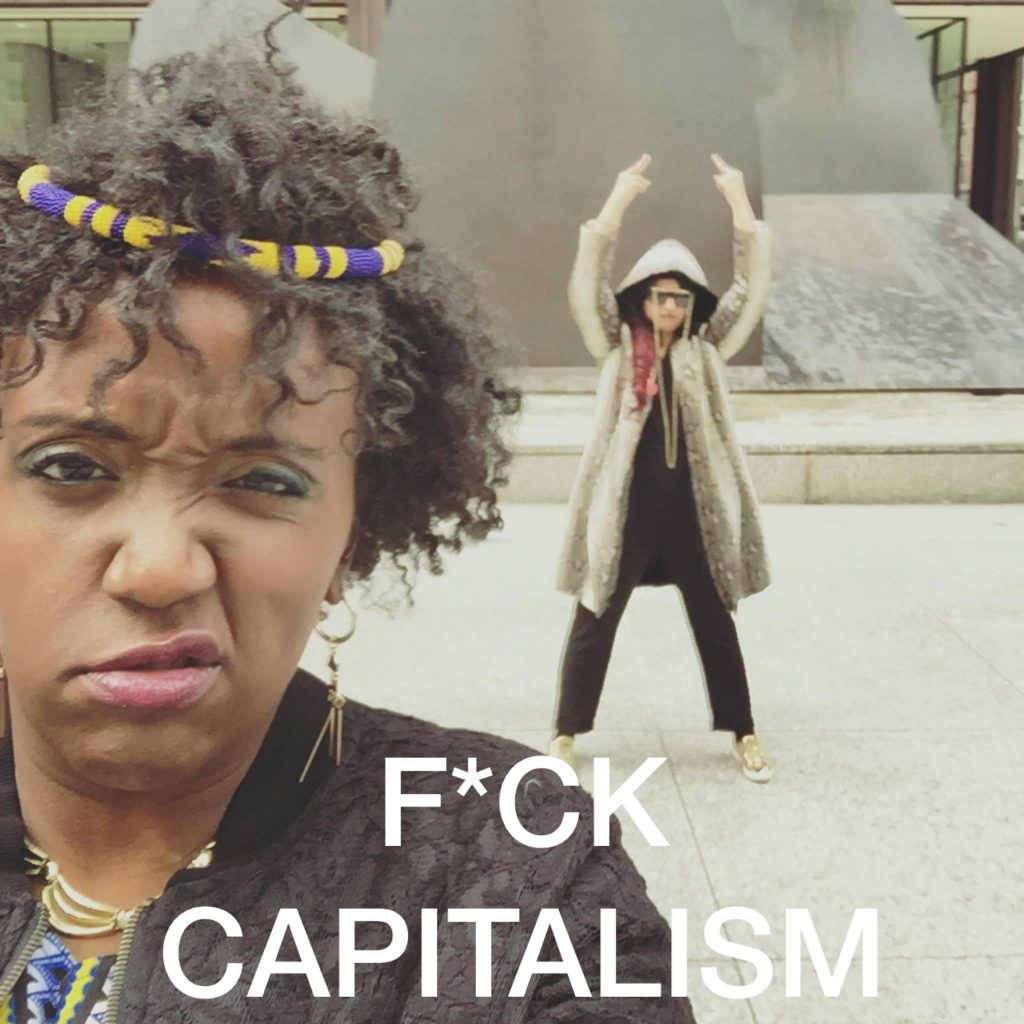
In order to keep going, we’re going to have to pause and talk about “development” and “gentrification.” We need to think about what these words mean, not simply in our vernacular, but how they have been constructed over time within the white-supremacist legal system of the United States and the larger narrative of colonialism and neo-colonialism worldwide. Housing is a fraught issue in the United States, in particular in relationship to African American communities. For a really good primer, I suggest The Case for Reparations by Ta-Nehisi Coats. He traces the ways racist federal policy and small moneylenders effectively gutted the post-War black middle class. We can also look to the geographer Neil Smith. In his book The New Urban Frontier: Gentrification and the Revanchist City Smith highlights the use of “frontier” language in modern discourses of gentrification (the shift from the “urban jungle” to the “urban pioneer”) and traces the history of frontier colonialism beyond the pioneer mythology. In particular that the 19th century frontier was “extended westward less by individual pioneers, homesteaders, rugged individualists, than by banks, railways, the state, and other collective sources of capital…” He concludes that the same forces are at play in the metaphor of the “urban frontier” where lenders, banks, real estate developers and retail corporations are the driving forces: “the construction of the new urban frontier of the fin de siècle is a political geographical strategy of economic reconquest…” While Smith says that the frontier mythology is distinctly American, he does note its use in Europe and ties it to issues of gentrification globally. We cannot ignore that the uniquely American concept of Manifest Destiny, completely intertwined in the frontier, has its roots in European thought and white supremacy, and thus to the larger global history of colonialism. As Smith notes, this urbanism is revanchist, with distinctly American white supremacist undertones as it “embodies a revengeful and reactionary viciousness against various populations accused of ‘stealing’ the city from the white upper classes.”
So, across the country, post World War II, black middle class communities were gutted of wealth through racist federal policy. While we shouldn’t discount rural African Americans, we cannot ignore that a large portion of those effected by this policy were black people in urban areas. We cannot forget that this happens smack in the middle of the Great Migration, where southern African Americans migrated to urban areas in the Northeast, Midwest, and West to escape the overt white supremacy of Jim Crow laws and social structures. The racial make-up of urban areas changes, just as systems are put in place to rob those populations of their wealth. Whites flee to the segregated suburbs and wait for property values, social services, and political organizing structures to collapse. All of a sudden real estate can be bought for pennies on the dollar and rented to artists and assorted bohemians. From there, the “urban pioneer” or “urban cowboy” enters the scene to “take back” the territory. As Smith notes, “contemporary urban frontier imagery treats the present inner-city population as a natural element of their physical surroundings.” And in the American/colonial imagination, nature is to be managed and exploited. It has no history, no selfhood. The natives are there to be placated and controlled, not to be equal partners in the future.
Is it really impossible, then, to understand what is happening in Macon? It is the same thing that is happening everywhere. The “taking back” of the city has come to full fruition in the “taking back” of the country this November. Marginalized people are either awarded honorary white person status, policed, or expelled. The Father will not tolerate discontent. This might be the moment when you ask, how could the NEA and the Knight Foundation fund this project? Neil Smith wrote The New Urban Frontier in 1996. All you really need to do is read the introduction, which shouldn’t take twenty years. But maybe, the ideology of revanchist urbanism isn’t that far removed from the ideology of the art world, and public art in particular.
Also written in the mid-nineties, Erika Doss’s examination of public art titled Spirit Poles and Flying Pigs explores the intersection of public art, democracy, and capitalism in the late eighties and early nineties. She starts by critiquing the flattening of “the public” that public art (often funded by the NEA) tends to produce, looking at Jürgen Habermas’s 1960s theory of the public sphere, which feminist scholar Nancy Fraser called “a masculinist ideological notion that functioned to legitimate an emergent form of class rule.” Doss writes: “In deference to a model of a single, passive, and ideal public sphere, Habermas failed to recognize its inherent conflicts and the hosts of counter-publics—women, workers, racial groups, and so on—who were excluded from this ideal realm and who created their own public spheres and public cultures.” In the same way that revanchist urbanism imagines the city as a blank canvas for “development” public art often imagines the public as an empty vessel to be filled with the aesthetic education and the ordering forces of art. Later, Doss writes: “because modern art meshed with the postwar elite’s insistence that the public sphere needed to be ordered, and thus controlled, it was embraced by them as the most desirable aesthetic for the public sphere.” (For a really interesting analysis of modern art and power, check out Minimalism and the Rhetoric of Power by Anna C. Chave). In addition to public art funded by federal and local governments, Doss goes on to trace how public art is often used by corporations as a shield (or a salve) to smooth over their usurpation of public space—one example is Promenade Classique in Alexandria, Virginia, a privately funded sculpture garden that was built in conjunction with a number of office buildings on what was once public land. Possibly the most blatant enunciation of this rhetoric can be seen when Doss quotes Mobil’s vice president of public affairs: “We remove the arts and humanities from the category of things done because they’re nice…and we demonstrate instead that patronage is just another aspect of the marketplace, another move you make there to sell your products and enlarge your share.”
In a more contemporary example, we can take a look at this article in the Washington Post that popped up on my Newsfeed a few months ago. Here, the counter-cultural aesthetic of “street art” has been taken up by developers to smooth the process of gentrification. Artists happily participate in this project of colonialism that “celebrates” the very cultures and people it is expelling. For decades, public art has been doing the labor of enforcing neoliberal “order” in the urban frontier, both through publically funded projects and private projects supported by corporations and developers. It appears that in Macon, the once radical discourse of “Social Practice” has been absorbed into the same machine.
It’s time to return to Fed Moten and Stephano Harney. In Chapter 1 of The Undercommons, they open with a synopsis of Michael Parenti’s anti-imperial analysis of Hollywood movies. He points to films where the settler is portrayed as surrounded by natives, “inverting the role of aggressor, so that colonialism is made to look like self-defense.” Moten and Harney take up this example, but suggest that the settler really is surrounded, by an undercommons that exists outside of the ordering of politics and institutions. If, like the University, our arts institutions are simply another facet of the State, which works to exclude the everyday resistances of the undercommons, to turn the professional and the critical academic alike into agents of State power and authority, then how can we re-read, understand, and perhaps “know” what happened to Samantha and Ed? Moten and Harney tell us that the subversive academic will always be labeled “unprofessional” her behavior almost criminal in that she rejects the “negligence” of professionalization and the critical academic, that she embodies passion and care. And isn’t this what happened in Macon? Samantha and Ed were accused of not fulfilling the “professional” obligations of their residency by not complying with the project of colonialism that they encountered. Instead of reading the situation—as Art F City and others who wrote about it did—as a conflict between two entities with equally “good” intensions, we must treat the very reality of their expulsion as a kind of evidence. To ban, to make an outcast, to remove, these are actions taken by the neoliberal State when it cannot manage one’s labor, when one is excessive, when one’s very presence is a problem.
Where does that leave us, as artists laboring in the shadow of a new era of fascism? When the real estate developer has become the president? I’m not sure I’m ready to supply an answer. But I know the machine continues, as do the resistances. So maybe, like Samantha and Ed, we must all have the courage to care, to resist the negligence imposed by institutions, to bring our passion and our unprofessionalism, to bring our full selves to every moment. To have the courage to be expelled, to be the outcast, the criminal. The subversive artist says yes. The subversive artist says no. The subversive artist says yes and no. Because she knows the stakes. She holds the future in her heart, the queer divine black future, with all its impossibilities. Our present condition is one of peril. The foxes are in the henhouse, have infiltrated every position of power. Their jaws are around our necks. They are starting to squeeze. As we feel their teeth pierce our flesh, we fall back on our most basic instincts. In the animal world, this is fight or flight. I recently learned that in humans, there is a third option in that primal moment: banding together. Solidarity is a basic instinct. It is at the core of our humanity. It is the root of art. It is the possible impossibility.
Read the interview with Samantha Hill and Ed Woodham.
Featured Image: “Donald Trump Exorcism with the Goddess Saraswati” performance that was part of the #NewGlobalMatriarchy livestream for Acre TV, 2016 (Photo courtesy of Maya Mackrandilal and Stephanie Graham)
 Maya Mackrandilal is an LA based transdisciplinary artist and writer. She holds an MFA from the School of the Art Institute of Chicago and a BA from the University of Virginia. She has shown her artwork nationally. In her writing, which has appeared in publications such as The New Inquiry, Drunken Boat, contemptorary, Skin Deep, and MICE Magazine, she focuses on issues of race, gender, and labor. You can find her tweeting about politics and art @femme_couteau and can follow her on Facebook. Her website is mayamackrandilal.com.
Maya Mackrandilal is an LA based transdisciplinary artist and writer. She holds an MFA from the School of the Art Institute of Chicago and a BA from the University of Virginia. She has shown her artwork nationally. In her writing, which has appeared in publications such as The New Inquiry, Drunken Boat, contemptorary, Skin Deep, and MICE Magazine, she focuses on issues of race, gender, and labor. You can find her tweeting about politics and art @femme_couteau and can follow her on Facebook. Her website is mayamackrandilal.com.
